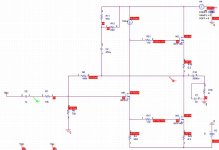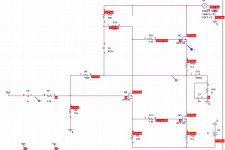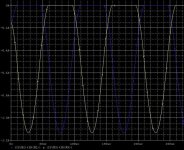tlf9999 said:
it should have enough voltage output as well. give it a try and let's say what happens.
I also simulated yours (2n5401 input, 2n5551 vas, and irf510 output). they are biased similarly to yours (1.3ma input, 4.5ma vas on 9ma ccs, and 600ma output). the gain is set at 40x. As I don't have a model for 2sk170, I used a perfect ccs in my circuit.
It performed identical to my version of jlh posted earlier. I tried to dial back the gain, or to increase the output impedance of the source (to 100k) and the perform is unaltered.
So in theory yours should work. I suspect now that the problem is either in wiring or in component selection.
Hi,Mr.Graham & Mr.tlf9999:
thank you at fist for reply...
I have already try using headphone output to drive my IRF510's JLH mos amp,it must turn to MAX of the volume position,and I didn't heard difference,so I suppose that isn't my CD's problem,after know yours can hear bass well,I think this my loudspeaker's problem,my speaker just only 3" full range speaker units,perhaps it can't process well bass than yours...but they sounds wonderful, I like them very much!so more strong bass my speaker needed,and more low frequency output from my designed AMP...that is why I think the JLH1969 can't process bass well and do modification with it...
I still carry on my idea!because it has more width frequency response...

have fun,my friends!
WINCO
I guess that point is that it is less likely what you experienced can be attributable to the circuit. If you want improvement, you may have to look elsewhere.
Graham Maynard said:Original JLH open loop can be circa 50dB, with device dependency.
Thanks. I worked up a low feedback version and wanted a
reality check.
😎
Re: 1291
yes!I have to build one for reference...if it's bass can make me satisfy,that I have do is not necessary at all...if it still like what I say,that is to say JLH1969 is has weak point in it's BASS...I will report if I done this compare...
regards!
WINCO
HOEK said:Hi Darkhorse
Try a real JLH69, you will forget your simulations.
GREET HOEK
yes!I have to build one for reference...if it's bass can make me satisfy,that I have do is not necessary at all...if it still like what I say,that is to say JLH1969 is has weak point in it's BASS...I will report if I done this compare...
regards!
WINCO
Hy Darkhorse
I made a JLH69 (monoblocks) a few months ago.
The bass and the treble are really good.
I compared the JLh to a Rotel (RC972-Rb971)
The JLH give me a lot more music,
the sound is more easy to hear
I can not explain the reason for it.
Greet HOEK
I made a JLH69 (monoblocks) a few months ago.
The bass and the treble are really good.
I compared the JLh to a Rotel (RC972-Rb971)
The JLH give me a lot more music,
the sound is more easy to hear
I can not explain the reason for it.
Greet HOEK
Hi Tim,
Regarding source impedance;-
I am not going to attempt to give any specific rules in this regard, other than repeat JLH's prior recommendation.
It is thus most likely that anyone driving a JLH amplifier directly from a potentiometer or a source having output resistance greater than 1k could enjoy better reproduction definition than they realised was possible with such a simple circuit.
I must leave it up to each user to check out their own source arrangements, and maybe this is one reason why some constructors are entirely satisfied whilst others cannot understand how they could be !
Hi Darkhorse,
I do not know of any 3" driver capable of producing full 'bass' from a flat system.
Cheers ........ Graham.
Regarding source impedance;-
I am not going to attempt to give any specific rules in this regard, other than repeat JLH's prior recommendation.
It is thus most likely that anyone driving a JLH amplifier directly from a potentiometer or a source having output resistance greater than 1k could enjoy better reproduction definition than they realised was possible with such a simple circuit.
I must leave it up to each user to check out their own source arrangements, and maybe this is one reason why some constructors are entirely satisfied whilst others cannot understand how they could be !
Hi Darkhorse,
I do not know of any 3" driver capable of producing full 'bass' from a flat system.
Cheers ........ Graham.
Graham Maynard said:
Hi Darkhorse,
I do not know of any 3" driver capable of producing full 'bass' from a flat system.
Cheers ........ Graham.
here here - but I'm also wondering about what kind of cabinets you are using. The kind of design and correct design makes a huge difference to bass reproduction even with a 3" speaker
Graham Maynard said:
I do not know of any 3" driver capable of producing full 'bass' from a flat system.
Headphones ? 😀
john linsley- hood
Hi everyone, i know its slightly off topic but has anyone got the circuit diagram(schematic) of jl-hood's pa amplifier which was published in electronics today international ETI in the mid-late 80s? Thanks.P.S. it was of hifi quality and an interesting design!
Hi everyone, i know its slightly off topic but has anyone got the circuit diagram(schematic) of jl-hood's pa amplifier which was published in electronics today international ETI in the mid-late 80s? Thanks.P.S. it was of hifi quality and an interesting design!
For all you JLH fans out there ...
The one-and-only has published a draft of an excelent article on the JLH topology:
www.passlabs.com/np
grzzz,
Thijs
The one-and-only has published a draft of an excelent article on the JLH topology:
www.passlabs.com/np
grzzz,
Thijs
tschrama said:The one-and-only has published a draft of an excelent article on the JLH topology:
so hopefully there will be no doubt that the mosfet version of the JLH is indeed JLH, 🙂.
Here is my implementatio of the PLH.
a few observations:
a) the amp porformed very well and tracked the JLH1969 well.
b) the gain is quite sensitive to the phase splitter used. I got 10x gain with irf510/610, but only 4x with other irf540/p140 and mje15032. Not sure if it is a model problem or there is something special about the irf510/610.
c) the use of a current source as the load helped improve the gain. However, disortion goes through the roof if the amp is not biased in class A. the bootsrape network offers comparable performance but allows the amp to be biased in class AB. To me, that is a superior arrangement.
Attachments
tlf9999 said:a chart of current going through the mosfets.
Nice class AB operation.
hi,tlf9999:
don't forget add one resistor to upper mosfet's G & S pins,you can seaching X-PRO's post in this thread,you can see his schematics of JLH mos amp...
cheers
WINCO
😉
DarkHorse said:don't forget add one resistor to upper mosfet's G & S pins,you can seaching X-PRO's post in this thread,
is X-Pro's amp better than Nelson's?
played around with the input stage a little.
With IRF510, the gain starts to dip at 10khz, and phase shift is quite excessive: 70 degrees at 100khz. However, distortion is almost non-existant.
With 2n5551, the gain stayed flat all the way to about 100khz. and phase shift is about 30 degrees at 100khz. However distortion is just shy of .5%.
I am a little torn between using a small signal mosfet and a fast BJT. I will try to listen to both this weekend and see how they sound.
With IRF510, the gain starts to dip at 10khz, and phase shift is quite excessive: 70 degrees at 100khz. However, distortion is almost non-existant.
With 2n5551, the gain stayed flat all the way to about 100khz. and phase shift is about 30 degrees at 100khz. However distortion is just shy of .5%.
I am a little torn between using a small signal mosfet and a fast BJT. I will try to listen to both this weekend and see how they sound.
tlf9999 said:
is X-Pro's amp better than Nelson's?
hi:
haha...both are audio master!but I think X-PRO is more professional in research this circuit topology...
regards!
WINCO
tlf9999 said:is X-Pro's amp better than Nelson's?
For me this is a bit like saying what is better oranges or apples
If I had sensitive enough speakers and / or I was driving the bass with another amp, I'm guessing ( my own amp having similarities to X-pros and having just built Nelson's one in spice ) that I MAY prefer Nelson's, especially on some cd's that seem to emphasise detail. On other recordings, that already sound smooth on my system, it may be I would prefer mine or X-pros or something inbetween these and the PLH
I do not think that Nelson's amp would excell with 87db/W/M speakers with a 4 ohm tweeter and 8 ohm mid/bass unit with impedance dropping to 1.5 ohms in the cross-over region for instance....on the other hand with 102dB / W / m speakers in some kind of horn, Nelson's amp I'm sure would up there with the best ......but there will still be many who may prefer a SET or Susan Parker zeus type amp or firstwatt current drive or valve push pull.....
Not to even mention power supply design
As well as absolute design quality there is a large amount of horses for courses / amps for speakers AND personal preference that makes black & white comparisons, like the question is apparently looking for, almost completely meaningless.
Having said all that, being a Luddite at heart, I really like the back to basics simple, clever, listening based, designs in which Nelson seems to excel. All of which means I am going to build one to hear for myself which ultimately is the only way for each of us to find out which is "best"...😉
DarkHorse said:
hi:
haha...both are audio master!but I think X-PRO is more professional in research this circuit topology...
regards!
WINCO
I am just curious as to what research x-pro has done.
- Home
- Amplifiers
- Solid State
- JLH 10 Watt class A amplifier


